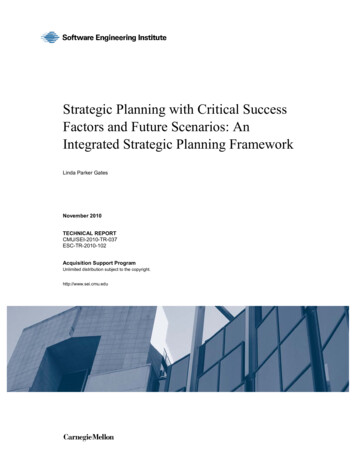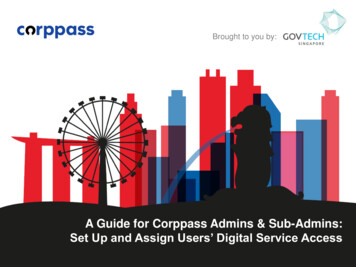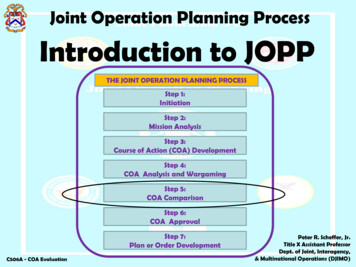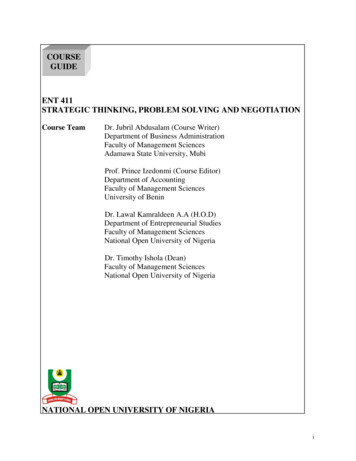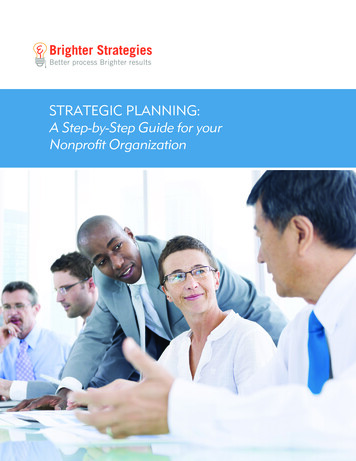
Transcription
STRATEGIC PLANNING:A Step-by-Step Guide for yourNonprofit Organization
AcknowledgementBrighter Strategies, LLC would like to give special thanks to the individuals who made significant contributions to thedevelopment of this guide. These include:Elizabeth Scott, PhDElizabeth Scott, PhD, founder of Brighter Strategies, provides thought leadership and high value organizationaldevelopment consulting in support of a stronger social sector. Liz has provided training and consulting services instrategic planning, process-improvement, and human capital development for over 170 nonprofits and associationsand has facilitated over 25 Board of Director retreats. She has extensive experience in developing and managingall aspects of an organization’s quality and business improvement efforts; such as developing and administeringprograms, training and coaching employees, and facilitating organization-wide change. She has been a Baldrigeexaminer for the Commonwealth of Virginia and is a certified Standard of Excellence consultant. In addition tomanaging the practice, Liz holds a faculty position at The Chicago School of Professional Psychology where sheteaches in the Business Psychology Department. Liz holds an undergraduate degree in Sociology and a master’sdegree in Organizational Sciences from The George Washington University, as well as a second master’s and Ph.D.in Human and Organizational Systems from Fielding Graduate University in Santa Barbara, California. She lives inFalls Church, Virginia with her husband, two dogs and two cats.Ann RiveraAnn Rivera is Senior Community of Practice Manager, Human Capital and Senior Leaders & Executives, for theAssociation for Talent Development (ATD). Prior to this position, Ann worked at ATD in an editorial capacity, primarilyfor TD magazine, as Senior Writer/Editor. In this role Ann had the privilege to talk to many talent developmentpractitioners, hear from a variety of prominent industry thought leaders, and develop a rich understanding of theprofession’s content. In addition to her full-time position at ATD, Ann is a freelance writer/editor for Brighter Strategies,and a freelance writer for The Huffington Post. 2017 Permission is granted to reprint or reproduce the information contained in this publication as long as it isproperly attributed to Brighter Strategies.2STRATEGIC PLANNING: A Step-by-Step Guide for Your Nonprofit Organization
Table of ContentsIntroduction. 4Strategic Planning: The Basics. 6The Strategic Planning Process for Nonprofit Organizations. 9Step #1: Lay the Groundwork. 10Step #2: Build the Pillars of Planning—The “MVV”. 14Step #3: Identify Strengths, Problems, Opportunities, and Threats—The SPOT Analysis. 16Step #4: Create Strategic Goals. 18Step #5: Set Strategic Measures—The Balanced Scorecard. 23Step #6: Write and Communicate the Strategic Plan. 28Step #7: Execute the Strategic Plan. 31Step #8: Review the Strategic Plan. 33Concluding Thoughts: Time to walk the talk. 34
IntroductionThis guide provides valuable information that will help your organization to effectively develop a strategic plan. Ourhope is that in distributing this workbook, we at Brighter Strategies can give you the information and practical tools youneed to make strategic planning simple and successful for your organization.The content of this guide is designed to:1. Work within your organization’s culture. Every nonprofit should have a strategic plan. However, no one strategicplan is the same. Using your organization’s unique identity and specialized resources is the key to effectivestrategic planning.2. Emphasize continuous quality improvement (CQI). The journey is more important than the destination; the goalis to continuously improve your organization’s planning, processes, people, and performance. Use this guide on anongoing basis as you regularly revisit and revise your organization’s strategic plan.3. Give you take-away tools. From crafting your mission, vision and values statements to conducting a SPOT analysisand creating a balanced scorecard, the practical exercises and informative resources in this workbook will makestrategic planning a reality in your agency.4. Be interactive. This guide includes a familiar friend who pops up throughout the BrighterStrategies resource guides. The cartoon character Mr. PACE will appear within this workbookto remind you to pace yourself! When you see Mr. PACE, take a breather and use the spaceprovided to reflect, jot down notes, complete an exercise, and, ultimately, apply the learningto your professional context.Mr. PACEAfter reading and completing this workbook, you will be able to:1. Understand strategic planning basics, including definition, types, and process for nonprofit organizations.2. Lay the groundwork by establishing a strategic planning team and schedule, and conducting a gap analysis.3. Craft mission, vision, and values statements, which are the pillars of planning.4. Conduct a SPOT analysis to determine your organization’s strengths, problems, opportunities, and threats.5. Create goals based on your organization’s value proposition.6. Develop a balanced scorecard with measures to track the progress of your goals.7. Write and communicate the plan to necessary staff, stakeholders, and community groups.8. Execute the plan and review and adapt it regularly.4STRATEGIC PLANNING: A Step-by-Step Guide for Your Nonprofit Organization
hy are you reading this guide about strategic planning? What information do you hope toWtake away? What do you wish to do in your organization as a result? Use the space below toanswer these questions and create your learning plan before you proceed.5STRATEGIC PLANNING: A Step-by-Step Guide for Your Nonprofit Organization
Strategic Planning: The BasicsThe term “strategic planning” is as commonplace in organizations today as any number of business jargon phrases such as“low-hanging fruit” or “reach out.” But do you really understand what strategic planning is? Can you explain it to others or,better yet, implement it effectively in your nonprofit organization?Business acumen is an important skill for any professional to develop, regardless of his role in the organization. Familiarizingyourself with the background and definition of strategic planning not only will give you an advantage in your currentplanning endeavor, but will be invaluable for your career journey in the long-term.Strategy is plan, pattern, position, and perspective: Plan: how we intend to realize our goals Pattern: the rhyme and reason that emerges when making the decisions that reconcile the reality we encounter with theends we seek Position: the stance we take Perspective: both vantage point and the view from that vantage point, particularly the way this view shapes and guidesdecisions and actionsThere are three basic forms of strategy: Strategy in general is concerned with the relationship between the ends and the means Corporate strategy involves the markets in which a corporation will operate, or the mission by which a nonprofitwill function Competitive strategy defines the basis on which a business will compete, or the values by which a nonprofit will performOne way of understanding strategy is by seeing it as a blue ocean. This concept was introduced by W. Chan Kimand Renee Mauborgne who describe “red oceans” as all of the industries in existence today, and “blue oceans” asall of the industries not in existence today—the “open waters” in which demand is created, rather than fought over. Acompany that operates in a blue ocean creates value for its clients and stakeholders while simultaneously reducing oreliminating programs or services that are less valued by current or future clients.6STRATEGIC PLANNING: A Step-by-Step Guide for Your Nonprofit Organization
To differentiatebetween the various forms of strategy and begin thinking about howthey pertain to your organization, consider the following questions. Choose one of thecategories below and jot down your answers as best you can at this point. Using theprocess presented in this guide, you will explore similar concepts in depth with yourstrategic planning teammates.Related to the organization’smission, vision, and values Related to strategy in generalqqqqqqWho are we?What do we do?Why are we here?What kind of company are we?What kind of company do we want to become?What kind of company must we become?What is our objective—what are the ends we seek?What is our current strategy—implicit or explicit?What courses of action might lead to the ends we seek?What are the means at our disposal? How are our actions restrained and constrained by themeans at our disposal?q What risks are involved and which ones are seriousenough that we should plan for them?qqqqqRelated to corporate (mission-led) strategyq W hat is the current strategy—implicit or explicit?q What assumptions have to hold for the current strategy tobe viable?q What is happening in the larger social, political, technical,and financial environments?q What are our growth goals?q For what communities and in which geographic areaswill we operate?Related to competitive (value-based) strategyq W hat is the current strategy—implicit or explicit?q What assumptions have to hold for the current strategyto be viable?q What is happening in the industry, with our sisteragencies, and in general?q What are our growth goals?q What services will we offer, and to which customers andshareholders?q What technologies will we employ?q What capabilities and capacities will we require—whichones are core?q By what values will we operate?*Adapted from “Three Form of Strategy: Corporate, Competitive and Strategy in General,” Fred Nickols, 2000.7STRATEGIC PLANNING: A Step-by-Step Guide for Your Nonprofit Organization
OK, so now you understand strategy. But what about the planning part?Strategic planning is an organization’s process of defining its strategy and making decisions on allocating itsresources to pursue this strategy. The remainder of this training guide will show you how to conduct this process foryour organization. Below, write in your own words what you’ve learned about strategy and strategic planningso far. Use the information above and describe these concepts in simple terms that you cancommunicate easily to your colleagues.Strategy:Strategic planning:8STRATEGIC PLANNING: A Step-by-Step Guide for Your Nonprofit Organization
The Strategic Planning Processfor Nonprofit OrganizationsClearly strategic planning is a complex practice, and it may sound daunting. The following pages are intended to, asmuch as possible, simplify strategic planning into a step-by-step process that works for your organization.This strategic planning process is designed specifically for nonprofit organizations. It primarily draws from themission, vision, values, and strategy in general questions posed in Figure A. It consists of three main components: plandevelopment, plan execution, and plan review.This training guide will focus primarily on plan development, the most critical part of the process. If a companydevelops its strategic plan well, it will set itself up for success with the remaining two components.Plan DevelopmentFigure A: Strategic Planning Process for Nonprofit Organizations1. L ay the groundwork by establishing ateam and examining the organization’scurrent situation.Reviewthe plan2. D etermine the organization’s mission,vision, and values statements.3. Identify the organization’s strengths,problems, opportunities, and threatsthrough a SPOT analysis.4. Set strategic organizational goals.Lay thegroundworkExecutethe planDeterminethe MVV5. D etermine strategic measures using abalanced scorecard.6. Write and communicate the strategic plan.Plan execution7. Execute the plan.Plan review8. Review the plan.9Conducta SPOTanalysisWrite andcommunicatethe planSTRATEGIC PLANNING: A Step-by-Step Guide for Your Nonprofit ls
Step #1: Lay the GroundworkLaying the groundwork, the first step in strategic plan development, comprises establishing a strategic planning teamand examining the organization’s current situation.Establish a team. For nonprofit organizations, team composition is crucial. When gathering your team, choosemembers who represent all organization stakeholders, both internal and external are in positions to speak and act with authority (power brokers and leaders) have a vested interest in the organization’s missionAlthough made up of individual members, the strategic planning team must be able to work as a collective body.Ensure that your team establishes specific roles for each member and understands how to operate effectively. For moreon building a strong strategic planning team, check out Brighter Strategies’s training guide, “Power Teams: CreatingEffective Work Groups that Get Things Done.” rteam Below, identify specific individuals who you think should be members of your organization’sstrategic planning team.10STRATEGIC PLANNING: A Step-by-Step Guide for Your Nonprofit Organization
At your team’s first meeting, create a tentative meeting schedule. The frequency of meetings will vary depending onthe size of the team and members’ availability. Meetings should take place no less than once a month, and no morethan once a week. or some extra accountability—in addition to updating your Outlook and smartphoneFcalendars, of course—jot down your team’s schedule here:MEETINGNUMBERMONTHDAYTIMELOCATION1September42 PMConferenceRoom 3,main2345611STRATEGIC PLANNING: A Step-by-Step Guide for Your Nonprofit OrganizationAGENDAA. Conduct introductionsB. Create meeting scheduleC. Begin discussion aboutorganization’s history
amine the organization’s current situation. Before you know where you want to be, you must understand where youare now and how you’ll get there.12STRATEGIC PLANNING: A Step-by-Step Guide for Your Nonprofit Organization
Figure B: Gap Analysis Organization HistoryBridging the Gap MVV Value proposition SPOT Analysis Strategic goals Plan execution Plan review Balanced scorecardAt this stage in the game, it’s necessary to determine where you are. In one of your first plan development meetings,capture the following: The organization’s history Stakeholders Current organization performance Prior planning efforts (if applicable)As the team discusses where your organization is, record the outcomes of your discourse TRATEGIC PLANNING: A Step-by-Step Guide for Your Nonprofit OrganizationPrior planning
Step #2: Build the Pillars of Planning—The “MVV”You have determined the organization’s past and current status. Now it is time to review the organization’s existingmission, vision, and values statements and decide if a revision is in order.An organization’s mission, vision, and values (MVV) guide its strategic plan. Therefore, this is a critical step inplanning—to determine, or reexamine, these foundational cornerstones of your organization. You can think of theMVV as your organization’s “most vital variables.” Or come up with an acronym of your own! Mission: the reason your organization exists—its purpose Vision: how the world will change as a result of your organization’s work—the array of things your organizationwould like to do Values: guidelines for choosing among competing priorities—should be manifested in everything your organizationand employees doThe below MVV examples come from the American Red Cross: Mission: The American Red Cross prevents and alleviates human suffering in the face of emergencies by mobilizingthe power of volunteers and the generosity of donors. Vision: The American Red Cross, through its strong network of volunteers, donors, and partners, is always there intimes of need. We aspire to turn compassion into action so that all people affected by disaster across the country and around the world receive care, shelter and hope our communities are ready and prepared for disasters everyone in our country has access to safe, lifesaving blood and blood products all members of our armed services and their families find support and comfort whenever needed in an emergency, there are always trained individuals nearby, ready to use their Red Cross skills to save lives. Values: humanity, impartiality, neutrality, independence, voluntary service, unity, universalityYour team should dedicate one of its first meetings to discussing the organization’s MVV through the following process: Prior to this meeting, assign a handful of team members to conduct a series of interviews with key stakeholders,posing questions about the MVV and sharing their responses as a foundation for group discussion. See Figure B forsome sample questions related to the MVV. Ask each team member to complete a survey or write a personal belief statement, and circulate results to capturethe range of ideas. Ask members with strong ideas to write a series of short discussion pieces exploring recurring themes andproposing solutions. A s a group, explore themes; discuss proposed solutions; and choose succinct mission, vision, and values statements.Vote on these final choices if necessary.* While determining the MVV can take place during one planning meeting, it often helps to dedicate at least twomeetings to the process so that team members have time to “sleep on” the proposed ideas.14STRATEGIC PLANNING: A Step-by-Step Guide for Your Nonprofit Organization
What are your organization’s mission, vision, and values? After completing the aboveprocess with your strategic planning team, record your MVV statements below:Mission:Vision:Values:15STRATEGIC PLANNING: A Step-by-Step Guide for Your Nonprofit Organization
Step #3: Identify Strengths, Problems, Opportunities,and Threats—The SPOT AnalysisOne of the most important steps in the strategic planning process, the SPOT analysis acts as the final informationgathering process to capture where your organization is.Credited to Albert Humphrey, who led a convention at the Stanford Research Institute in the 1960s and 1970susing data from Fortune 500 companies, the SPOT analysis is a strategic planning method used to evaluate anorganization’s strengths, problems, opportunities, and threats.*The traditional method is called a SWOT analysis, with the “W” standing for weaknesses, but we like to focus onproblems, which have solutions, rather than weaknesses, which are inherent flaws.The SPOT analysis groups key pieces of information about an organization into two main categories: Internal factors: the strengths and weaknesses internal to an organization Strengths: characteristics of the organization that you brag about Problems: realities of the organization that you know you have to face External factors: the opportunities and threats presented by the organization’s external environment Opportunities: chances to improve performance in the environment Threats: elements in the environment that could make the problems greaterAs part of strategic plan development, the SPOT analysis provides the following benefits: Determines the business and environmental factors affecting your organization Analyzes existing organization strategies to determine their relevance for the future plan A ids in developing new and revised strategies by informing your team whether or not specific objectivesare attainableBelow is an example of a SPOT analysis from the Department of Social Services.Strengths Experienced, resourceful,dedicated workforce Strong communitypartnerships/collaboration Continuous qualityimprovement that promotesteamworkProblemsOpportunitiesThreats Parking for customers Leadership training forpossible advancement Staff turnover Collaboration withcommunity partners Privatization D iminished resources;increased consumerdemand Uniformity acrossdivisions Proactive management team16STRATEGIC PLANNING: A Step-by-Step Guide for Your Nonprofit Organization Promoting teamworkacross divisions Identifying staff’shidden strengths Budget Fewer peoplewilling to do childwelfare
The SPOT analysis is a detailed process that may require several meetings to complete. One way to approach this stepin plan development is to dedicate four meetings to analysis—one for each of the SPOT components.Record the results of your company’s SPOT analysis here:Strengths17ProblemsSTRATEGIC PLANNING: A Step-by-Step Guide for Your Nonprofit OrganizationOpportunitiesThreats
Step #4: Create Strategic GoalsNow you that you know where your organization is, it’s time to establish how to bridge the gap to where you want to be.You’ve analyzed your organization’s internal business factors and external environmental factors through the SPOTanalysis, so now you can make an informed value proposition—the first step toward setting your strategic goals (alsoknown as objectives).Your value proposition describes how your company delivers value to stakeholders and clients. It is the solution to yourcustomers’ problem(s). Think of it as a lens through which you will develop your goals.There are three core types of value propositions. To narrow your strategic planning focus, your team should determinewhich of the below types your organization is best equipped to deliver: Operational excellence You can deliver your products, services, or programs at a lower cost than your competitors thanks to betterprocesses, economies, or other advantages. Your products, services, or programs are typical for the category—not the best and not the worst. Example: For more than 100 years, Goodwill has provided customized job training, employment placement, andsustainable commercial services to communities across the globe. Market leadership/innovation Your focus is innovation—new technologies and better products, services, or programs. Because your products, services, or programs are new, different, and unique, your prices are likely higher thanyour competition, but you’re delivering a superior solution. Example: The YMCA recently opened a Nathan’s Famous hot dog franchise in Pennsylvania that brings peoplethrough the Y but also helps fund their programs. Customer intimacy Your goal is to solve your customers’ problems with a broad portfolio or customized set of products, services, orprograms. You’re selling a relationship that is superior to the relationship offered by your competitors. Example: Reston Interfaith helps people to build more stable lives by connecting them to vital, customizedresources that solve their needs for housing, childcare, food, or financial assistance—rather than makingindividuals fit their pre-packaged services.Most companies focus on one or two of the above value propositions—it’s nearly impossible to deliver well on all three.When determining your organization’s value proposition, you may ask several leaders in marketing and sales to attendyour strategic planning team meetings. These professionals have skill sets that will be particularly useful for this stageof the process.The basic value proposition process involves: reviewing the results of your SPOT analysis determining your competitors’ value propositions identifying how your competitors solve your customers’ problems creating your organization’s own value proposition18STRATEGIC PLANNING: A Step-by-Step Guide for Your Nonprofit Organization
Below, define your organization’s value proposition.You’ve determined how your organization will deliver value and fulfill its mission, so now it’s time to create your goals.Strategic goals—also known objectives—are the means that help to bridge the gap illustrated in Figure B. They are themeat of strategic planning, the action items that are implemented to grow your organization today for tomorrow. Revisit your SPOT analysis. Keeping your value proposition in mind, determine the mostcritical strengths, problems, opportunities, and threats that you have identified. You shouldidentify three to five from each GIC PLANNING: A Step-by-Step Guide for Your Nonprofit Organization
4.5.Opportunities1.2.3.4.5.Threats1.2.3.4.5.Now it’s time to set some goals! An impact/effort grid is a practical tool to help with this task. It links the “problemstate”—where you are—to the “solved state”—where you want to be—by determining if the critical SPOT factors youjust identified involve easy effort/minor impact, easy effort/major major impact, difficult effort/minor impact, or difficulteffort/major impact.Figure C shows how sample SPOT factors fit within each quadrant.20STRATEGIC PLANNING: A Step-by-Step Guide for Your Nonprofit Organization
Figure C: The Impact/Effort GridIncrease clientintakes by 5percent annually.Organize community golfevent to raise money for theorganization.Call the golf course tocheck tournament dates.Ward off competitors bykeeping program participationprice points low.The impact/effort grid: helps to develop goal clarity provides a structure for examining the multi-dimensional nature of decisions and actions being contemplated inan organization provides a structure for analyzing patterns in goals and objectives and detecting potential conflict with goals andobjectives of competing organizationsFor example, suppose most of your objectives are clustered in the “difficult/minor” quadrant. This could mean you’reworking too hard on goals that give you little “bang for your buck.” Or, perhaps your objectives are crammed into the“easy/minor quadrant.” Could this indicate an unwillingness to take risks?21STRATEGIC PLANNING: A Step-by-Step Guide for Your Nonprofit Organization
Create your own impact/effort grid below.Examine the grid’s composition and ask yourself the hard questions:Is one quadrant too “heavy” with objectives? If so, why?How can you recreate goals to better serve your organization’s mission, vision, values, and valueproposition while balancing your efforts with your impact?22STRATEGIC PLANNING: A Step-by-Step Guide for Your Nonprofit Organization
Step #5: Set Strategic Measures—The Balanced ScorecardNow that you have determined your organization’s mission, vision, values, value proposition, and goals, it’s time tocreate your balanced scorecard (BSC). The BSC is a set of measurements that will track your organization’s progresstoward its goals and strategies.Developed by Robert S. Kaplan and David P. Norton, the BSC gives leaders a fast but comprehensive view of thebusiness. It: is a top-down reflection of the company’s mission and strategy is forward-looking integrates external and internal measures helps you focusThe BSC allows leaders to look at the business from four important perspectives and to focus on a handful of measuresthat are most critical by assigning them to these perspectives: Client/Stakeholer perspective: How do clients/stakeholders see us? Client/stakeholder concerns tend to fall into four categories: time, quality, performance and service, and cost. Organizations should articulate goals for these categories and then translate the goals into specific measures. Internal perspective: At what must we excel? Internal measures should stem from the business processes that have the greatest influence on client/stakeholder satisfaction, such as factors that affect quality, employee skills, and productivity. Organizations should attempt to identify and measure their core competencies—the critical capabilities neededto ensure continued program quality—and specify measures for each. Innovation and learning perspective: Can we continue to improve and create value? An organization’s ability to innovate, improve, and learn ties directly to its value. Organizations should measure their ability to launch new services, create more value for client/stakeholder, andimprove performance. Financial perspective: How do we look to stakeholders? Financial performance measures indicate whether or not the organization’s strategy, implementation, andexecution are contributing to bottom-line improvement. Typical goals have to do with operational reliance, program return on investment (ROI), growth, and financial stability.The original BSC (Kaplan and Norton’s) was quite simple, linking strategic goals to specific measures (see Figure D).23STRATEGIC PLANNING: A Step-by-Step Guide for Your Nonprofit Organization
Figure D: The Balanced ScorecardFINANCIAL“How do we lookto stakeholders?”CLIENT/STAKEHOLDERMISSION“How do clients/VISIONstakehold
4 STRATEGIC PLANNING: A Step-by-Step Guide for Your Nonprofit Organization Introduction This guide provides valuable information that will help your organization to effectively develop a strategic plan. Our hope is that in distributing this workbook, we at Brighter Strate


